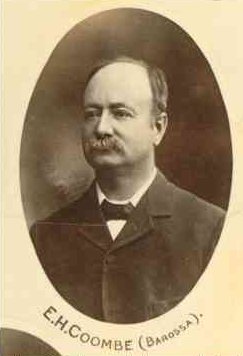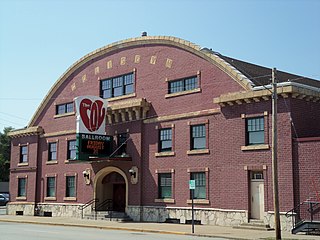Related Research Articles

The Barossa Valley is a valley in South Australia located 60 kilometres (37 mi) northeast of Adelaide city centre. The valley is formed by the North Para River. It is notable as a major wine-producing region and tourist destination.

Tanunda is a town situated in the Barossa Valley region of South Australia, 70 kilometres north-east of the state capital, Adelaide. The town derives its name from an Aboriginal word meaning water hole. The town's population is approximately 4600. The postcode is 5352

Sängerfest, also Sängerbund-Fest, Sängerfeste, or Saengerfest, meaning singer festival, is a competition of Sängerbunds, or singer groups, with prizes for the best group or groups. Such public events are also known as a Liederfest, or song festival. Participants number in the hundreds and thousands, and the fest is usually accompanied by a parade and other celebratory events. The sängerfest is most associated with the Germanic culture. Its origins can be traced back to 19th century Europe. Swiss composer Hans Georg Nägeli and educator Carl Friedrich Zelter, both protégés of Swiss educator Johann Heinrich Pestalozzi, established sängerbunds to help foster social change throughout Germany and Prussia. University students began to choose the art form as an avenue for political statements. As the sängerfest concept gained popularity and spread around the world, it was adapted by Christian churches for spiritual worship services. European immigrants brought the tradition in a non-political form to the North American continent. In the early part of the 20th century, sängerfest celebrations drew devotees in the tens of thousands, and included some United States presidents among their audiences. Sängerbunds are still active in Europe and in American communities with Germanic heritage.

Barossa German is a dialect of German, predominantly spoken in the Barossa Valley region of South Australia. The prominent South Australian writer, Colin Thiele (1920–2006), whose grandparents were German immigrants, referred to "Barossa-Deutsch" as: "that quaintly inbred and hybrid language evolved from a century of linguistic isolation". It takes its name from the Barossa Valley, where many German people settled during the 19th century. Some words from Barossa German have entered South Australian English.
German Australians are Australians with German ancestry. German Australians constitute one of the largest ancestry groups in Australia, and German is the fifth most identified European ancestry in Australia behind English, Irish, Scottish and Italian. German Australians are one of the largest groups within the global German diaspora. At the 2021 census, 1,026,138 respondents stated that they had German ancestry, representing 4% of the total Australian population. At the 2021 census, there were 107,940 Australian residents who were born in Germany.

John Howard Angas was an Australian pioneer, politician and philanthropist.

Ephraim Henry Coombe was a South Australian newspaper editor and politician. He was editor of the Bunyip at Gawler from 1890 to 1914. He was a member of the South Australian House of Assembly from 1901 to 1912 and 1915 to 1917, representing the electorate of Barossa. A long-time liberal in the House, he refused to join the united conservative Liberal Union in 1910, and was defeated in 1912 recontesting as an independent. Following his defeat, he edited the Daily Herald from 1914 to 1916. He was re-elected to the House for Barossa in 1915, having joined the Labor Party, but died in office in 1917.

The Barossa Light & Gawler Football Association, more commonly referred to as the BL&GFA, is an Australian rules football competition based in the Barossa Valley, Gawler Region and Light Region of South Australia, Australia. Just 42 kilometres north of the state capital of Adelaide, the BL&GFA is an affiliated member of the South Australian National Football League. In 2022, Nuriootpa secured the premiership cup for a record equalling eighth time. The current president of the League is Mick Brien and the major sponsor of the league is the Grant Burge Winery.

The Col Ballroom is a historic building located in the West End of Davenport, Iowa, United States. It was listed on the National Register of Historic Places and on the Davenport Register of Historic Properties as the Saengerfest Halle.

The Burnside Symphony Orchestra is a community orchestra based in the Burnside Council area in Adelaide, South Australia. While most concerts presented are in the Burnside Ballroom, the orchestra sometimes repeats performances outside the Adelaide metropolitan area, offering rural towns the chance to hear live performances of popular classical music.

Martin Peter Friedrich Basedow was a native of Hanover, Germany who arrived in South Australia aboard the Pauline in March 1848.
Moritz Heuzenroeder was a pianist, composer and teacher of music born in Germany who had a substantial career in South Australia.
Brisbane Apollo Male Choir is the longest running male choir in Brisbane, Queensland, Australia. Formed in 1884, the choir still performs today.
The Australische Zeitung was a weekly German-language newspaper published in Tanunda, South Australia from 1860 until it ceased publication during World War I in 1916 due to anti-German sentiment. The newspaper also existed in a variety of earlier names or merged publications, reflecting the fluid nature of the newspaper industry in Victorian gold rush era colonial South Australia. The long history of German language Australian newspapers reflects the considerable German-speaking population which settled in South Australia in the nineteenth century.
Carl Wilhelm Ludwig Muecke, occasionally written Mücke and frequently referred to as "Dr Muecke", was a German-born clergyman, plant pathologist and German-language newspaper editor in the colony of South Australia.
There have been a number of organisations known as the German Club in Adelaide, South Australia. The two most notable ones are:
The Adelaide Liedertafel is a traditional German male choir, one of several Liedertafeln, or song societies, in the history of Adelaide and South Australia. It is Australia's oldest male choir.
Arthur Hermann Otto was an organist, composer, singer and teacher of music in Adelaide, South Australia. He had a later singing and teaching career in England as Arthur Kingston-Stewart.
Brenton James Langbein, AO was an Australian violinist, conductor, and composer.

Minna Pauline Fischer was an Australian lyric soprano and singing teacher in London.
References
- ↑ "Local News". The South Australian . Vol. XIV, no. 1211. 10 January 1851. p. 2. Retrieved 4 August 2018– via National Library of Australia.